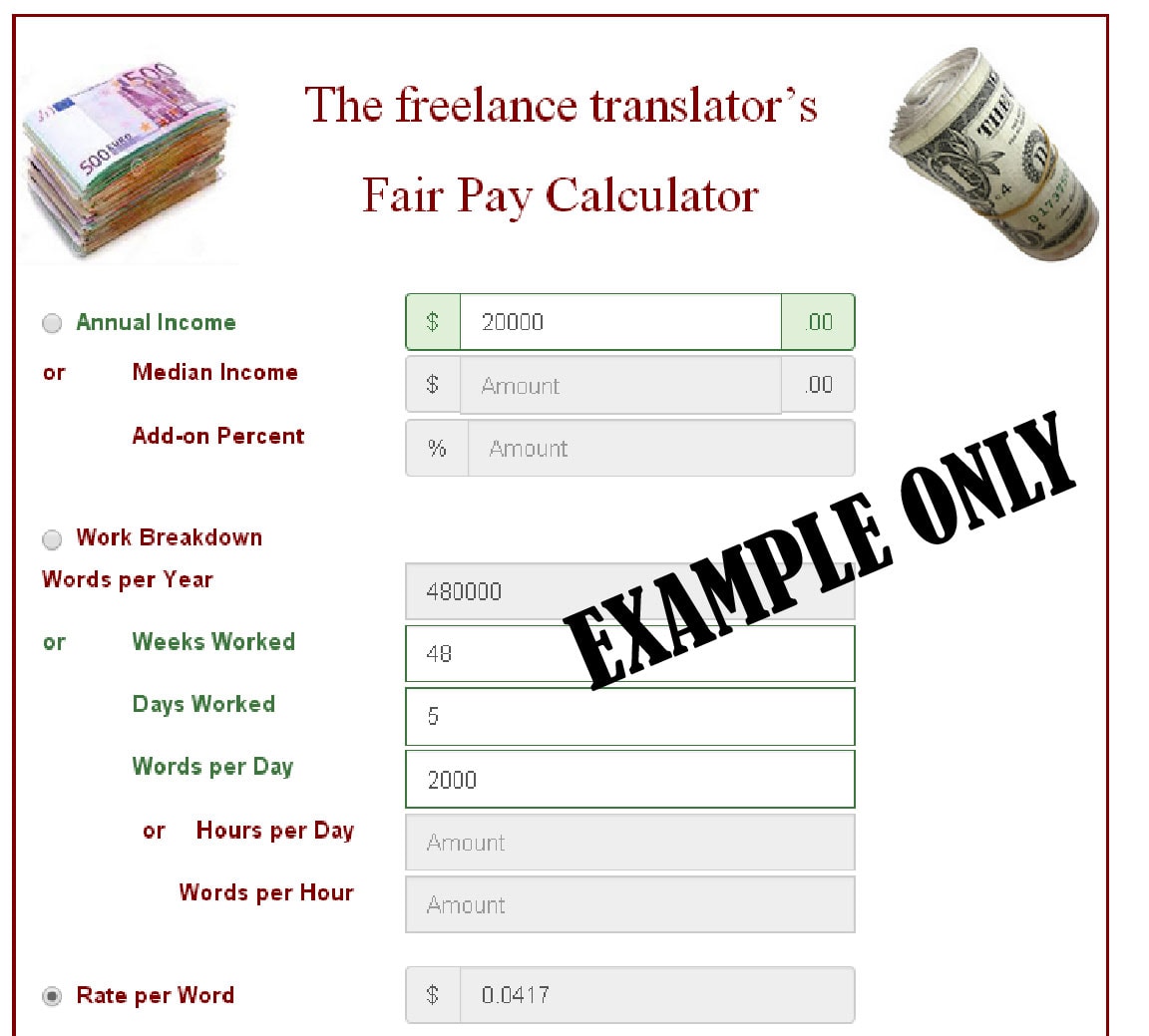Some freelancers really struggle when it comes to setting their translation rates.
They know they want to earn a decent living, but … don’t know what rate per word will let them do that.
That’s understandable – doing those calculations can seem a bit daunting.
Well, we’ve just changed all that …
We’ve created simple tool with an easy 2-step process that any freelancer can use to see in seconds what translation rate they need to charge to be fairly paid for their services:
The Freelance Translator’s Fair Pay Rates Calculator
We think you’ll like it – and particularly the peace of mind from knowing the rates you decide to charge are soundly and logically based.
But this handy tool can do much more than just help you decide what translation fees to charge. You can also use it to:
- project your yearly earnings
- figure out what hours you’ll need to work to reach your target income
- calculate how many words per hour or day you need to translate
- see how increasing your words per day output affects your income
- see what effect increasing or decreasing your translation charges has on your income
In fact, pretty much everything you’re likely to want to calculate.
In a rush?
Jump straight to:
- Use the Calculator
- 2 examples of freelance translation rate calculations using the Calculator
- Your guide to determining what freelance translator rate to charge
- Three other calculations you might want to run
Using the calculator to set your translation fees is as simple as entering a few key numbers, and we’ll explain those below.
But first, some examples.
Using the Fair Pay Calculator to set your freelance translation rates – 2 examples
Example 1 from Argentina
A translator posted recently on the Proz Money Matters forum that US20,000 a year was an acceptable salary for her in Argentina right now.
What translation rate per word would she have to charge to generate that level of income?
Here’s one possible calculation:
So, if she translates 2000 words per day and works 5 days a week she’ll need to charge more than $0.04 per word to earn $20,000 per year.
Example 2 from Australia
The average annual salary in Australia is currently around AUD80,000.
What rate per word would a freelance translator need to charge to earn this average wage?
Here’s one scenario:
The Fair Pay Calculator tells us with an average translation output of 2500 words per day you’ll need to charge more than AUD13 per 100 words to earn the average wage in Australia.
Try the calculator for yourself!
Simply:
- Select the button for what you want to calculate
- Complete the fields in the two other sections
- See your answer!
You can then:
- change figures for a new answer
- double click a greyed out field to re-set that section
- reset and select another button for a different calculation type
Your 2-step guide to determining what freelance translator rate to charge using the Fair Pay Calculator
With “Rate per Word” selected,
1. Enter your target Annual Income
or Medium Income and an Add-on %;
2. Enter your Words per Year figure
or use the other Work Breakdown fields to generate that figure.
Your rate per word is calculated automatically.
To work out what rate per word you need to charge to earn what for you would be a decent living, you first need to know two things:
- What annual income you’re aiming for
- How many words you expect to translate
Pop these numbers into the Calculator, and you’ll have your answer.
These two steps can cause some difficulty though, so here’s how we suggest you tackle them.
Step 1: Work out your annual translation income target
Many freelance translators will know how much they want or expect to earn. That’s great.
But some aren’t so sure.
If you’re one of those, here are two ways you might use to set your target income figure:
Method 1
Firstly, find out the median or average annual full time salary in your country.
How? Simply do a Google search with “median salary” + your country, or variations on this:
Take care the figure you end up with is reliable though.
We recommend looking for authoritative sites like a Government agency/department presenting statistics, or companies giving work survey results.
Some traps to watch out for
Make sure the figure you come up with:
- isn’t actually the figure for household income
- doesn’t include part time employees
- doesn’t include those out of work or searching for work
- is reasonably up to date
Once you’ve got your figure, consider:
Secondly, decide on an Add-on percentage
Question: do you deserve to be earning more than what half the population earn?
As a professional translator you’ve studied for several years. You’ve got advanced foreign language abilities. And you’re a skilled writer, right? That’s a skillset very few people have.
We know Mox with his 2 PhDs and 6 languages barely earns the minimum wage, but surely you as a talented and experienced translator deserve more than the median or average wage …
Consider adding a percentage to the salary figure to reflect your true worth.
The median is the half way point of a list of all salaries earned.
The average is the total of all salaries earned divided by the number of earners.
In many countries there won’t be much difference between these two. However if there are a large number of very high earners in your country the average will be skewed higher. Conversely if many people earn very little, the average may be unrealistically low.
In either of these cases the median is probably more useful. But it may be harder to find than the average.
And you will also need to consider …
As a freelancer you have costs that wage earners typically don’t face. For example:
- business registration and compliance
- accountants’ fees
- insurance (professional liability / indemnity cover in case you get sued isn’t cheap. Then there’s accident and health cover, plus insuring your office …)
- training & professional development
- hardware & software
- potential bad debts
- your home office
- marketing, promotion
- etc
It can be an instructive, and sometimes sobering, exercise to add up all these additional costs of being in business in your country.
We think you should either add these to your required salary figure, or allow for them in your add-on percentage.
Tip: you might find the CalPro spreadsheet useful for identifying all these expenses.
Still not sure what percentage to add?
For a somewhat rough and ready calculation we suggest adding 10 or 15% to the median salary figure.
Method 2
Try searching for “salary guide” or “salary review”, or variations on this.
Look for recruitment agencies publishing their latest salary surveys on their websites.
Then pick a profession you think is broadly comparable to you as a translator.
Bear in mind your years of training and the specialised skillset you’ve developed – what you choose should have broadly similar features. Or pick more than one and average the figures.
Choosing a good comparison may not be that easy. Whatever you do, don’t sell yourself short.
Important: And of course you still have your self-employed business expenses that wage and salary earners don’t incur. We recommend totaling these up (see box above) and adding them on to the salary figure you choose.
Step 2: Work out your yearly translation volume
Again, some translators will already know how many words they expect to translate a year.
If that’s you, enter your figure straight in the Calculator.
If not, it’ll need to be calculated from:
- The amount of time you’ll work
- Your translation output
This is what you need to do:
1. Decide on the time you’ll spend translating
You’ll need to set the number of weeks a year and days per week you’ll work, and optionally the number of hours per day.
Weeks per year
Everyone needs a holiday, so it’s obviously not 52. And you might get sick occasionally. 48 is more realistic.
Days per week
You might want to work six days a week, especially initially to build up your business. But for most people I imagine it will be 5. Congratulations to those who choose to work only 3 or 4!
Remember this is an average, so it can’t be 7 …
Hours per day
(Not needed if you enter the number of words you translate per day)
Most quality focused translators won’t consistently translate for 8 hours a day as they find that too much. 5 or 6 hours a day would be their number.
Others though will do longer hours. Everyone’s different and you’ll know your own limits, and how long you will typically work.
And of course as a freelance translator you’re also in business. You need time to run your business. That means time in administration, marketing, accounts, etc. Allow for this.
And now to the nitty gritty …
2. Set your translation output (words per hour or day)
We’ve all read on the forums translators’ stated average hourly and daily output. At the lower end its 200 an hour and 1200 a day. At the higher end it’s 500 an hour and 4,000 a day.
Above that there are the apparent super-achievers supposedly regularly cranking out 6 to 8 thousand words a day. Personally I can’t even begin to fathom those numbers.
Of course a lot depends on how much repeat text there is, familiarity with the subject matter, and the degree of quality required.
For most projects, I imagine a quality-focused translator producing 2,500 or 3,000 words a day would be a pretty solid effort.
Whatever figure you decide is right for you, remember it is the average, not your best effort. This is the volume you’ll average day in day out over months or a year.
That’s it – note once you’ve got your rate you can now:
- change figures to see what rates different parameters will give you
- double click a greyed out field to re-set that section
- reset and do the calculation again, or select another button for a different calculation type
Don’t overestimate your time or output figures.
If you do, your translation price per word will be skewed too low. Which means you probably won’t be charging enough to achieve your target income.
It’s vital to ensure all these figures are as realistic as possible.
Three other related calculations you can easily run with the Fair Pay Calculator
1. Calculate your projected annual income
- Select Annual Income
- Enter your Rate per Word
- Enter your Words per Year figure, or use the other Work Breakdown fields to generate that figure
- Your projected income is calculated automatically
You can now experiment by altering some of the work parameters or even your translation price per word to see the effect that will have on your income.
2. See how much time you’ll have to spend translating
- Select Work Breakdown
- Enter your Annual Income and your Rate per Word
- The words per year you’ll need to translate is calculated automatically
- Complete either Words per Hour or Words per Day
- You can now experiment with different figures in the remaining fields to see the effect on the hours, days, weeks you’ll need to work
You can also change your income figure or per word translation rate to see what effect that has.
3. Determine how many words you’ll need to translate
- Select Work Breakdown
- Enter your Annual Income and your Rate per Word
- The words per year you’ll need to translate is calculated automatically
- Complete all or selected time fields (weeks, days, hours) to see your required daily or hourly word volume
- You can now see how changing any of the time fields affects your required output
You can also change your income or per word charge to see how that would affect your required output.
Other useful references and information on how to set your freelance translation rates
Here are three other calculators we’ve found, although they’re not as flexible as the Fair Pay Calculator. The first two will calculate a per word rate and yearly translation volume starting from a desired income:
– Translate Media calculator
– Proz translator rates calculator. This also has a companion article – Determining your rates and fees as a translator.
– ATA calculator. This will compute your monthly or annual income based on your translation rate and volume.
There is also the CalPro spreadsheet and calculator – the original Spanish version and US localised version. Being a downloadable Excel file, this has the advantage that you can keep your results and re-visit/update them over time.
CalPro is excellent for determining your costs and productive time. It’s pretty comprehensive so is necessarily a bit complex and will take some time to work through, but will give you great insight into key areas of your business so is well worth the effort.
Of the many great translator blog discussions and suggestions on money matters we particularly recommend:
Nikki Graham: Let’s talk money. Excellent practical tips on setting your rates based on a minimum desired income, with great examples.
Judy and Dagmar Jenner: The twins nail it in tip 9 of their 10 Getting Started tips – “Do the math to see how much you need to make to have a thriving business, and charge the rate that gets you there“. Exactly.
Corinne McKay: More highly practical advice on setting rates based on billable hours, your salary goal and the cost of being in business. Many other great posts, including this on green (go), yellow (whoa) and red (no!) rates.
Tess Whitty on the pros and cons of different pricing methods and podcast 18 with Luke Spear on value pricing.
Karen Rückert: This guest post from Karen’s coach gives great guidance on how to determine your value as a professional translator.
Words to good effect: Marian’s thought-provoking post on what professions we should compare ourselves to, and what that means for translator pay levels.
Articles, guides, checklists and templates – all designed to help freelance translators with the practical side of being in business.
We’ve got great tips for your website, cv, getting work, quoting and a whole lot more.
See our translator tips and resources page for a full list.
Or start with one of these 3 highly popular articles:
5 pathways to a monster freelance translator salary
13 proven strategies for getting more freelance translation work from agencies
How to create the ideal freelance translator website












